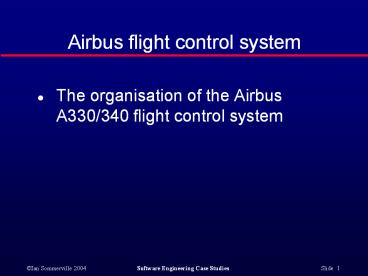Airbus flight control system - PowerPoint PPT Presentation
Title:
Airbus flight control system
Description:
The organisation of the Airbus A330/340 flight control system Fly by wire control Conventional aircraft control systems rely on mechanical and hydraulic links ... – PowerPoint PPT presentation
Number of Views:859
Avg rating:3.0/5.0
Title: Airbus flight control system
1
Airbus flight control system
- The organisation of the Airbus A330/340 flight
control system
2
Fly by wire control
- Conventional aircraft control systems rely on
mechanical and hydraulic links between the
aircrafts controls and the flight surfaces on
the wings and tail. The controls and flight
surfaces are directly connected. Mechanical links
are also used for the engine control. - In fly-by-wire systems, the cockpit controls
generate electronic signals that are interpreted
by a computer system and are then converted into
outputs that drive the hydraulic system connected
to the flight surfaces. Engine control is also
mediated by the FCS computers.
3
Advantages of fly-by-wire
- Pilot workload reduction
- The fly-by-wire system provides a more usable
interface and takes over some computations that
previously would have to be carried out by the
pilots. - Airframe safety
- By mediating the control commands, the system can
ensure that the pilot cannot put the aircraft
into a state that stresses the airframe or stalls
the aircraft. - Weight reduction
- By reducing the mechanical linkages, a
significant amount of weight (and hence fuel) is
saved.
4
Fault tolerance
- Fly-by-wire systems must be fault tolerant as
there is no fail-safe state when the aircraft
is in operation. - In the Airbus, this is achieved by replicating
sensors, computers and actuators and providing
graceful degradation in the event of a system
failure. In a degraded state, essential
facilities remain available allowing the pilot to
fly and land the plane.
5
Hardware organisation
- Three primary flight control computers
- Responsible for calculations concerned with
aircraft control and with sending signals to the
actuators associated with the control surfaces
and engines. - Two secondary flight control computers
- Backup systems for the flight control computers.
- Control switches automatically to these systems
if the primary computers are unavailable. - Only one computer is required for flight control.
- Therefore, quintuple redundancy is supported. All
operational computers operate in parallel so
there is no switching delay. - Two data concentrator computers
- Gather information from the flight control system
and pass this to warning and display systems,
flight data recorders and maintenance systems.
6
Hardware diversity
- The primary and secondary flight control
computers use different processors. - The primary and secondary flight control
computers are designed and supplied by different
companies. - The processor chips for the different computers
are supplied by different manufacturers. - All of this reduces the probability of common
errors in the hardware causing system failure.
7
Computer organisation
Command unit
Splitter
Comparator
Output
Input
Monitor unit
Flight control computer
8
Computer organisation
- The command unit and the monitor unit are
separate channels within a single computer. - Each channel has separate hardware and different
software. - If the results of the channels disagree (as
checked by the comparator) or are not produced at
the same time then an error is assumed and
control switches to another machine.
9
Software diversity
- The software for the different channels in each
computer has been developed by different teams
using different programming languages. - The software for the primary and secondary flight
control computers has been developed by different
teams. - For the secondary computers, different languages
are again used for the different channels in each
machine.
10
Dynamic reconfiguration
- The FCS may be reconfigured dynamically to cope
with a loss of system resources. - Dynamic reconfiguration involves switching to
alternative control software while maintaining
system availability. - Three operational modes are supported
- Normal - control plus reduction of workload
- Alternate - minimal computer-mediated control
- Direct - no computer-mediation of pilot commands.
- At least 2 failures must occur before normal
operation is lost.
11
Control diversity
- The linkages between the flight control computers
and the flight surfaces are arranged so that each
surface is controlled by multiple independent
actuators. - Each actuator is controlled by different
computers so loss of a single actuator or
computer will not mean loss of control of that
surface. - The hydraulic system is 3-way replicated and
these take different routes through the plane.
12
Airbus FCS problems
- There have been a number of Airbus accidents that
may be related to problems with the FCS. - One accident (Warsaw runway overrun) has been
clearly identified as a problem with the
specification and not with the system itself. - There is no evidence of any failures of the FCS
hardware or software. - However, the pilots may misinterpret how the
system operates and hence make errors that it
cant cope with. Most likely when the system was
newly introduced.

